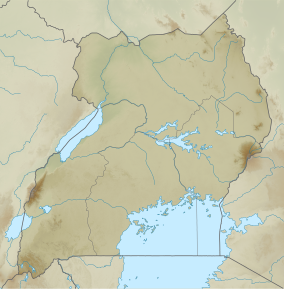The Ajai Wildlife Reserve is a small conservation protected area in North Western Uganda dominated by a large island surrounded by seasonally flooded swamps and wooded savanna.[1]
| Ajai Wildlife Reserve | |
|---|---|
| Ajai's Island | |
| Nearest city | Arua |
| Coordinates | 2°52′N 31°17′E / 2.867°N 31.283°E |
| Area | 148 km2 (57 sq mi) |
| Established | 1965 |
Location
editAjai lies on the western bank of the White Nile, approximately 40 km (25 mi) east of Arua.[2]
History
editHistorically, Ajai Game Reserve was only declared in limited area of 4 square Kilometers as a Game Sanctuary by the British Government in 1937. Prior to this, the former President Theodore Roosevelt of the United States of America (USA) had visited in King Ajai's palace during his African expedition in 1910. During President Roosevelt's expedition he hunted several White Rhino's which drastically reduced the number of White Rhinos in the reserve. Five years later, approximately 1915, King Ajai started supervising hunting in the area. Ajai's efforts later led to the declaration of a controlled area about 4 square kilometers by the government in 1937. The area declared a sanctuary was part of King Ajai's palace and didn't extend beyond. By the time Ajai Reserve was gazetted in 1965, the Ajai Rhino Sanctuary was home to 60 of Uganda's 80 remaining white rhino. The WWF funded an anti-poaching project there in 1962.
In 2002 Uganda Wildlife Authority began efforts to enlarge the boundaries of the reserve with a view of later re-introducing the White Rhino's into the reserve following years of the surviving Rhinos being kept at the Ziwa Rhino Sanctuary in Nakasongola District. These efforts of government have reached advanced stages with the hope of improving the tourism earnings and economic development of the local communities and the nation.
In 2008 the Uganda Wildlife Authority privatized the operation of Ajai. The concession went to Uganda Wildlife Safaris Ltd, a hunting and photographic tour operator.[3]
Wildlife
editThe reserve supports around 35 kilometers of papyrus swamp along with grassy floodplains and Savannah woodland. Large mammals present include leopard, Uganda Kob, sitatunga, hippo, black-and-white colobus and warthog, and there are reputedly long-term plans to introduce southern white rhinos.[4][5]
Getting there
editTo get to Ajai from Arua, follow the surfaced Packwach Road south for 15 kilometers to Olevu, then branch left on to a 40 kilometer dirt road running east to the reserve.
References
edit- ^ "Ajai". ugandawildlife.org. 2022-05-06. Retrieved 2024-06-13.
- ^ IUCN Conservation Monitoring Center; Parks, IUCN Commission on National; Areas, Protected (1987). IUCN directory of afrotropical protected areas. Gland, Switzerland: IUCN. p. 889. ISBN 2880328047. Retrieved 22 August 2013.
- ^ Mugabi, Frank (31 December 2008). "UWA delegates Ajai park management". New Vision. Archived from the original on 22 August 2013. Retrieved 22 August 2013.
- ^ Briggs, Philip (2016). Uganda: The Bradt Travel Guide. England: Bradt Travel Guide Ltd. p. 322. ISBN 9781784770228.
- ^ "Ajai Wildlife Reserve | Uganda Safaris Tours | Uganda Wildlife Tours". Achieve Global Safaris. 2022-07-21. Retrieved 2024-06-13.
